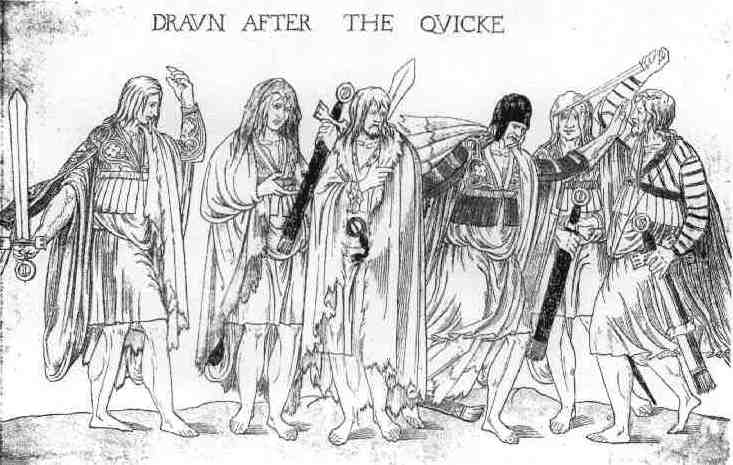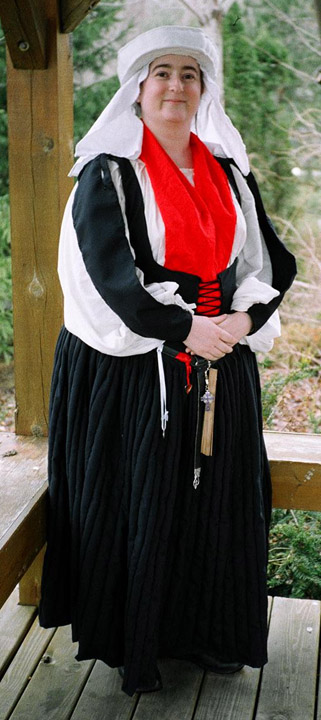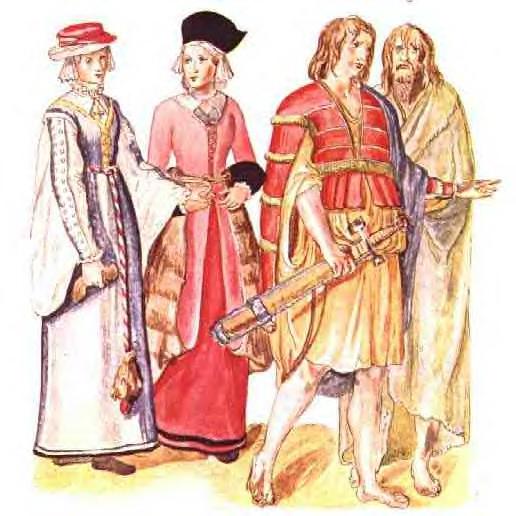Difference between revisions of "Leine"
(→Links) |
|||
| Line 1: | Line 1: | ||
| − | N. An Irish Undershirt. Leine is still common Irish parlance for 'Shirt' or 'top'. Pronounced (Lay-nen). [[Image:16thcentLeine.jpg.jpeg|thumb|Men wearing long | + | N. An Irish Undershirt. Leine is still common Irish parlance for 'Shirt' or 'top'. Pronounced (Lay-nen). [[Image:16thcentLeine.jpg.jpeg|thumb|Men wearing long [[Leine Fir]] with [[killcommon jacket]]s]] |
===In history=== | ===In history=== | ||
This was a garment worn by both men and women and was made of linen. For women it reached to the feet and for men to about ankle length. It was either made from bleached white linen or else a single bright colour which was described as 'gel'. It is possible that the white was reserved for ecclesiastical clothing with t he bright colours or plain linen being preferred by everyone else. The Book of Kells shows leines of various colours e.g. red, green and blue. | This was a garment worn by both men and women and was made of linen. For women it reached to the feet and for men to about ankle length. It was either made from bleached white linen or else a single bright colour which was described as 'gel'. It is possible that the white was reserved for ecclesiastical clothing with t he bright colours or plain linen being preferred by everyone else. The Book of Kells shows leines of various colours e.g. red, green and blue. | ||
[[Image:16th ce Irish.jpeg|thumb|Re-Enator wearing a split sleeves Irish dress with a Leine underneath]] | [[Image:16th ce Irish.jpeg|thumb|Re-Enator wearing a split sleeves Irish dress with a Leine underneath]] | ||
| − | The sleeves were wide or loose at the shoulder and tapered to a tight fit at the cuffs. | + | The sleeves were wide or loose at the shoulder and tapered to a tight fit at the cuffs. The 8th century illustrations show the leine as a loose fitting, single coloured garment decorated at cuffs, neck and hem with bands of braid or embroidery. There is no pictorial evidence for two, multi or parti-colored leini. The neck opening was usually circular with an occasional v shape being used. The plates of the Shrine of St Moedoc could possibly represent pleated leine as the folds seem too regularly defined for a representation of normal folds in cloth. As the shrine is 11th century it could possibly indicate a fashion or style change influenced by the Scandinavian pleated [[kyrtle]], worn also by the [[vikings]]. The leine was secured about the waist with a [[crois]] or [[belt]]. This was made of either [[tablet woven]] [[wool]] or rarely [[leather]] and would also serve for hanging a [[pouch]], knife or other articles. In warm weather or when engaged in work or fighting the leine would be 'pouched ' over the crois to allow greater mobility. |
===Fabrics=== | ===Fabrics=== | ||
It can be a little confusing trying to decide what fabrics to use when making a léine. The Tain, mentioned | It can be a little confusing trying to decide what fabrics to use when making a léine. The Tain, mentioned | ||
above, describes a number of léinte as silk or “glossy” in appearance. It makes reference to a linen léine | above, describes a number of léinte as silk or “glossy” in appearance. It makes reference to a linen léine | ||
| − | once | + | once. Both Dunlevy and McClintock concede that the léine was almost always a linen garment, and that the Tain is given to heroic excess in its descriptions. However, it should be noted that the Irish had [[silks]] available to them, especially after the appearance of Norse settlements, and that it was likely a status symbol to own as much as possible. Markets in Limerick in the 10th century had silks and silk satins of many colors available, as well as many other rich fabrics. The vast majority of this fabric would have been used for trim and decoration, not entire garments. |
| − | garment, and that the Tain is given to heroic excess in its descriptions. However, it should be noted that | ||
| − | the Irish had silks available to them, especially after the appearance of Norse settlements, and that it was | ||
| − | likely a status symbol to own as much as possible. Markets in Limerick in the 10th century had silks and | ||
| − | silk satins of many colors available, as well as many other rich fabrics. The vast majority of this fabric | ||
| − | would have been used for trim and decoration, not entire garments | ||
| − | Today the term “linen” refers to fabrics made from flax, but in the Middle Ages linen may also have been | + | Today the term “linen” refers to fabrics made from flax, but in the Middle Ages linen may also have been made of ramie, hemp or nettle fibers '''(Disputed)'''. A léine made of ramie may be even more authentic than one made of flax linen, as flax was not as abundant as nettles in Ireland, England, Man or Scotland, and nettles would have produced a fabric almost indistinguishable from ramie. (Ramie is actually made with a Chinese nettle and is one of the oldest textile plants known.) Hemp has a long and well-dispersed history as a textile plant for making linens; the oldest woven fabric found to date is made from hempen thread. After awhile, all of these fibers are nearly identical, even to experts. They make fine linens and should be seriously considered when fabric shopping. |
| − | made of ramie, hemp or nettle fibers. A léine made of ramie may be even more authentic than one made | ||
| − | of flax linen, as flax was not as abundant as nettles in Ireland, England, Man or Scotland, and nettles | ||
| − | would have produced a fabric almost indistinguishable from ramie. (Ramie is actually made with a | ||
| − | Chinese nettle and is one of the oldest textile plants known.) Hemp has a long and well-dispersed | ||
| − | history as a textile plant for making linens; the oldest woven fabric found to date is made from hempen | ||
| − | thread. After awhile, all of these fibers are nearly identical, even to experts. They make fine linens and | ||
| − | should be seriously considered when fabric shopping. | ||
[[Image:Irish Watercolor.jpeg|left|thumb|Irish men an women wearing Leine]] | [[Image:Irish Watercolor.jpeg|left|thumb|Irish men an women wearing Leine]] | ||
| − | Though linen may seem an extravagance these days, many medium-weight linens are available on the | + | Though linen may seem an extravagance these days, many medium-weight linens are available on the market, often for less than cotton/poly blends. Before you head to the local discount fabric outlet, consider this: most “linen” in such locations is not 100% linen, and the linen that is pure is usually astonishingly expensive. So you’ll find yourself settling for muslin that will wear out in a few years or a polyester blend that won’t breathe and is likely to melt when accidentally exposed to a campfire. Cotton can be more expensive. You’ll love how linen softens and you’ll save money being accurate and comfortable. |
| − | market, often for less than cotton/poly blends | + | |
| − | |||
| − | |||
| − | locations is not 100% linen | ||
| − | that is pure is usually astonishingly expensive. So you’ll find yourself settling for muslin that will wear out | ||
| − | in a few years or a polyester blend that won’t breathe and is likely to melt when accidentally exposed to a | ||
| − | campfire. Cotton can be more expensive. You’ll love how linen softens and you’ll save money being | ||
| − | accurate and comfortable. | ||
| − | |||
| − | |||
| − | |||
===Links=== | ===Links=== | ||
| − | *[https://www.reconstructinghistory.com/rh304-mans-l-ine.php?s=&c=22&d=35&q=1&p=51&w=21 Men's Leine Pattern] | + | *[https://www.reconstructinghistory.com/rh304-mans-l-ine.php?s=&c=22&d=35&q=1&p=51&w=21 Men's Leine (Leine Fir) Pattern] |
| − | *[https://www.reconstructinghistory.com/rh302-womens-l-ine.php?s=&c=22&d=35&q=1&p=49&w=21 Women's Leine] | + | *[https://www.reconstructinghistory.com/rh302-womens-l-ine.php?s=&c=22&d=35&q=1&p=49&w=21 Women's Leine (Leine Mna)] |
*[http://www.earlyirish.org/EarlyGaelicDress12col.pdf early Irish dress] | *[http://www.earlyirish.org/EarlyGaelicDress12col.pdf early Irish dress] | ||
| − | + | [[Category:Shirts]] [[Category:European Garb]] [[Category:Garb]] | |
| + | [[Category:Garb Undergarments]] [[Category:Irish Garb]] [[Category:Men's Garb]] [[Category:Women's Garb]] | ||
[[Category:Viking Garb]] | [[Category:Viking Garb]] | ||
Revision as of 16:23, 11 May 2009
N. An Irish Undershirt. Leine is still common Irish parlance for 'Shirt' or 'top'. Pronounced (Lay-nen).
In history
This was a garment worn by both men and women and was made of linen. For women it reached to the feet and for men to about ankle length. It was either made from bleached white linen or else a single bright colour which was described as 'gel'. It is possible that the white was reserved for ecclesiastical clothing with t he bright colours or plain linen being preferred by everyone else. The Book of Kells shows leines of various colours e.g. red, green and blue.
The sleeves were wide or loose at the shoulder and tapered to a tight fit at the cuffs. The 8th century illustrations show the leine as a loose fitting, single coloured garment decorated at cuffs, neck and hem with bands of braid or embroidery. There is no pictorial evidence for two, multi or parti-colored leini. The neck opening was usually circular with an occasional v shape being used. The plates of the Shrine of St Moedoc could possibly represent pleated leine as the folds seem too regularly defined for a representation of normal folds in cloth. As the shrine is 11th century it could possibly indicate a fashion or style change influenced by the Scandinavian pleated kyrtle, worn also by the vikings. The leine was secured about the waist with a crois or belt. This was made of either tablet woven wool or rarely leather and would also serve for hanging a pouch, knife or other articles. In warm weather or when engaged in work or fighting the leine would be 'pouched ' over the crois to allow greater mobility.
Fabrics
It can be a little confusing trying to decide what fabrics to use when making a léine. The Tain, mentioned above, describes a number of léinte as silk or “glossy” in appearance. It makes reference to a linen léine once. Both Dunlevy and McClintock concede that the léine was almost always a linen garment, and that the Tain is given to heroic excess in its descriptions. However, it should be noted that the Irish had silks available to them, especially after the appearance of Norse settlements, and that it was likely a status symbol to own as much as possible. Markets in Limerick in the 10th century had silks and silk satins of many colors available, as well as many other rich fabrics. The vast majority of this fabric would have been used for trim and decoration, not entire garments.
Today the term “linen” refers to fabrics made from flax, but in the Middle Ages linen may also have been made of ramie, hemp or nettle fibers (Disputed). A léine made of ramie may be even more authentic than one made of flax linen, as flax was not as abundant as nettles in Ireland, England, Man or Scotland, and nettles would have produced a fabric almost indistinguishable from ramie. (Ramie is actually made with a Chinese nettle and is one of the oldest textile plants known.) Hemp has a long and well-dispersed history as a textile plant for making linens; the oldest woven fabric found to date is made from hempen thread. After awhile, all of these fibers are nearly identical, even to experts. They make fine linens and should be seriously considered when fabric shopping.
Though linen may seem an extravagance these days, many medium-weight linens are available on the market, often for less than cotton/poly blends. Before you head to the local discount fabric outlet, consider this: most “linen” in such locations is not 100% linen, and the linen that is pure is usually astonishingly expensive. So you’ll find yourself settling for muslin that will wear out in a few years or a polyester blend that won’t breathe and is likely to melt when accidentally exposed to a campfire. Cotton can be more expensive. You’ll love how linen softens and you’ll save money being accurate and comfortable.


